Introduction
The global currency market is the largest and most liquid financial market, with a daily trading volume exceeding $6 trillion. This immense liquidity offers traders significant opportunities, but success requires a strategic approach, informed decision-making, and effective risk management. In this blog, we will explore the best trading strategies in the global currency market to help traders maximize their profits.
What is a Currency Trading Strategy?
A currency trading strategy is a well-defined plan that traders use to determine when to buy or sell currency pairs in the foreign exchange market. It involves analyzing market conditions, utilizing technical indicators, considering fundamental factors, and implementing risk management techniques to maximize gains while minimizing losses. Trading strategies can vary, including scalping, day trading, swing trading, and position trading, depending on a trader’s objectives and time horizon. A successful strategy requires discipline, backtesting, and continuous evaluation to adapt to changing market conditions. Additionally, money management and emotional control play crucial roles in executing a strategy effectively.
How to Develop a Currency Trading Strategy?
When selecting a currency trading strategy, it is crucial to understand your trading style and the strategies that align with your goals. Some traders stick to a single strategy, while others combine multiple approaches to optimize their trades.
Before choosing a strategy, consider the following factors:
• How much time can you dedicate to trading?
• Which currency pairs do you prefer to trade?
• What is the size of your portfolio?
• What is your risk tolerance?
1. Trend Following Strategy
One of the most popular currency trading strategies is trend following. As the name suggests, this approach involves identifying and trading in the direction of an established market trend, which can be bullish, bearish, or range-bound. Traders use technical indicators to identify trends and execute trades accordingly.
Key Indicators for Trend Following:
• Moving Averages (MA): Simple or exponential moving averages help smooth price data and highlight the trend direction.
• MACD (Moving Average Convergence Divergence): This indicator reveals the relationship between two moving averages, generating buy or sell signals.
According to a 2022 report by the CFA Institute, around 70% of successful currency traders rely on trend-following indicators such as moving averages and MACD to guide their trading decisions.
When the MACD line crosses above the signal line, it indicates bullish momentum, signalling a potential buy opportunity. Conversely, when the MACD line crosses below the signal line, it suggests a bearish trend, signalling a possible sell entry.
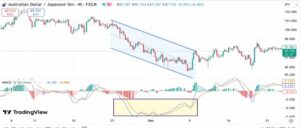
2. Range Trading Strategy
Range trading involves identifying key support and resistance levels where the currency price tends to fluctuate within a defined range. Traders enter buy orders near support levels and sell orders near resistance levels.
Key Insights:
• Works best in sideways or consolidating markets.
• Uses support and resistance levels to determine entry and exit points.
Statistical data from the Chicago Mercantile Exchange (CME) shows that 45% of currency traders use range trading strategies for short-term transactions. When applying this technique to the USD/SGD currency pair as depicted in below chart, we search for market scenarios in which the price is bouncing between two significant levels.
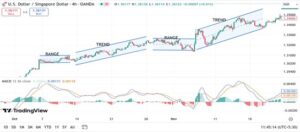
3. Scalping Strategy
Scalping is a short-term trading strategy that aims to profit from small price movements over brief periods, typically using 1-minute or 5-minute charts. Traders execute multiple trades throughout the day to accumulate small profits.
Key Indicator:
• RSI above 70: Overbought (potential sell signal)
• RSI below 30: Oversold (potential buy signal)
Traders combine RSI with other technical tools and risk management techniques to enhance trade success.
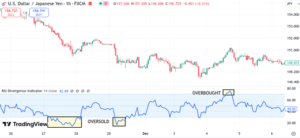
4. Carry Trade Strategy
The carry trade strategy involves borrowing a currency with a low interest rate and investing in a currency with a higher interest rate. The profit comes from the interest rate differential and potential capital gains.
Popular Currency Pairs for Carry Trade:
• AUD/JPY: The Australian Dollar usually has a higher interest rate than the Japanese Yen.
• NZD/JPY: The interest rate difference makes this a preferred pair for carry trading.
According to Investopedia, 20% of all currency transactions worldwide are carry trades, particularly during low-volatility periods when market conditions favor these trades.
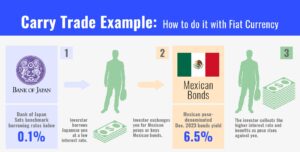
5. News Trading Strategy
News trading focuses on reacting quickly to major economic news and data releases that impact currency values. Key events such as Non-Farm Payrolls (NFP), GDP reports, interest rate decisions, and geopolitical developments create high volatility and trading opportunities.
Key Economic Indicators for News Trading:
• Non-Farm Payrolls (NFP): A crucial U.S. employment report that affects USD movements.
• GDP Growth: Economic performance data from major economies like the U.S., Europe, and China.
• Central Bank Announcements: Interest rate decisions and policy statements impact currency valuation.
A 2023 survey by IG Group found that 25% of currency traders use news trading to capitalize on market events, especially during volatile periods.
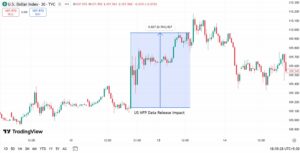
6. Money and Risk Management
Risk management is crucial for long-term success in currency trading, regardless of the strategy used. Traders must determine their risk tolerance and implement appropriate position sizing, stop-loss orders, and take-profit levels to protect their capital.
Risk Management Tools:
• Stop-Loss Orders: Set limits at key support or resistance levels to minimize potential losses.
• Risk-Reward Ratio: A ratio of at least 1:2 ensures potential profits outweigh risks.
Research from DailyFX shows that 50% of currency traders fail to apply proper risk management, leading to significant losses. Successful traders use tools like stop-loss orders and effective position sizing to mitigate risks.
Conclusion
The currency market presents multiple opportunities for traders, but achieving success requires a disciplined approach, robust strategies, and effective risk management. Understanding the core principles behind each strategy—whether trend following, range trading, scalping, news trading, or carry trading—enhances decision-making and profitability.
By utilizing these strategies along with the right technical indicators, traders can optimize their potential gains while effectively managing risks. With advanced chart analysis, traders can make informed real-time decisions and adjust their strategies as market conditions evolve.
Written By-

DHYEYA BHAVSAR
MBA Finance
Symbiosis International University
Capital Market Analyst Intern

